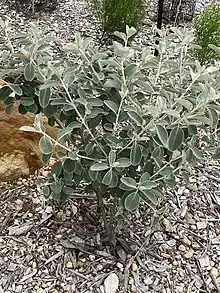| Diplolaena grandiflora | |
|---|---|
 | |
| Scientific classification | |
| Kingdom: | Plantae |
| Clade: | Tracheophytes |
| Clade: | Angiosperms |
| Clade: | Eudicots |
| Clade: | Rosids |
| Order: | Sapindales |
| Family: | Rutaceae |
| Genus: | Diplolaena |
| Species: | D. grandiflora |
| Binomial name | |
| Diplolaena grandiflora | |

Diplolaena grandiflora, commonly known as wild rose or Tamala rose, is a shrub which is endemic to Western Australia.[1]
Description
Diplolaena grandiflora grows to between 0.5 and 3 metres high and has an erect habit. In a period between late autumn and spring, it produces showy, upright or pendant flowers . These have a cluster of red stamens in the centre, surrounded by pinkish-red bracts. The leaves are ovate and are up to 5 cm in length and are dark green on the top and downy on the undersides.[2]
Distribution
Diplolaena grandiflora occurs on limestone outcrops and ridges in an area between Geraldton and North West Cape.[2]
Taxonomy
Despite its common name of "wild rose", it is not closely related to the rose, but rather it is placed in the family Rutaceae.[3]
The first known scientific collection of the species was by William Dampier during a voyage to New Holland in 1699.[4] The type specimen was collected in 1801 from Dirk Hartog Island during a French voyage of exploration captained by Jacques Hamelin and Nicholas Baudin. The specimen was brought back to France and described by René Desfontaines in 1817, who gave it the specific epithet of grandiflora meaning "large-flowered".[3]
Cultivation
Propagation is by cuttings or from seed. It prefers good drainage and part shade and requires pruning to enhance flower production.[5]
References
- ↑ Corrick, Margaret G.; Fuhrer Bruce A. (2009). Wildflowers of Southern Western Australia. Rosenberg Publishing. p. 193. ISBN 978-1-877058-84-4.
- 1 2 "Diplolaena grandiflora". FloraBase. Western Australian Government Department of Biodiversity, Conservation and Attractions.
- 1 2 "Diplolaena grandiflora". Australian Plant Name Index (APNI), IBIS database. Centre for Plant Biodiversity Research, Australian Government, Canberra. Retrieved 28 November 2011.
- ↑ "William Dampier - 300th Anniversary". Australian Plants Online. September 1999. Retrieved 27 November 2011.
- ↑ Wrigley J.W.; Fagg M. (1979). Australian Native Plants. William Collins Publishers Sydney, Australia. ISBN 0-00-216416-7.
External links
- "Diplolaena grandiflora Desf". Atlas of Living Australia.